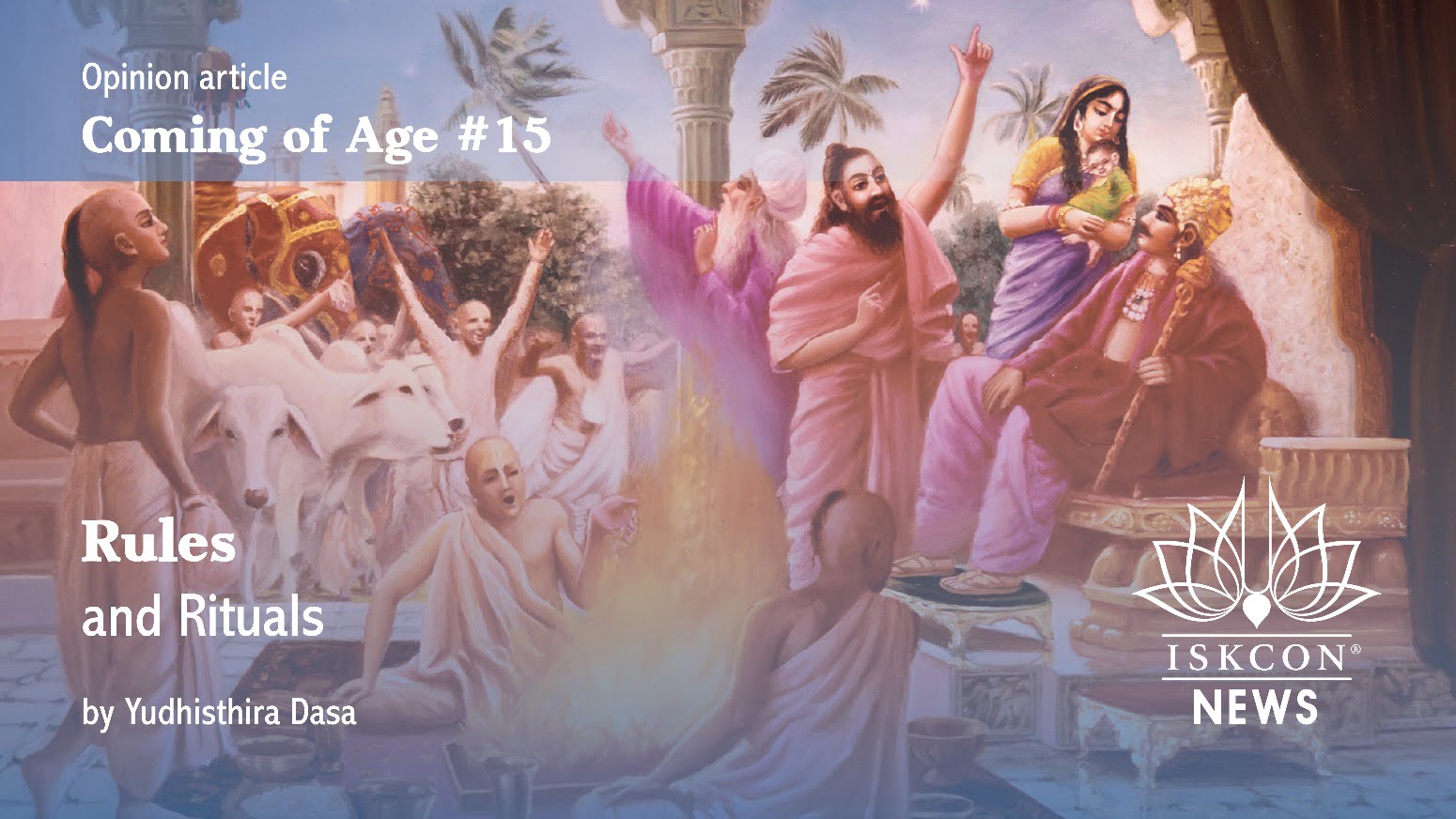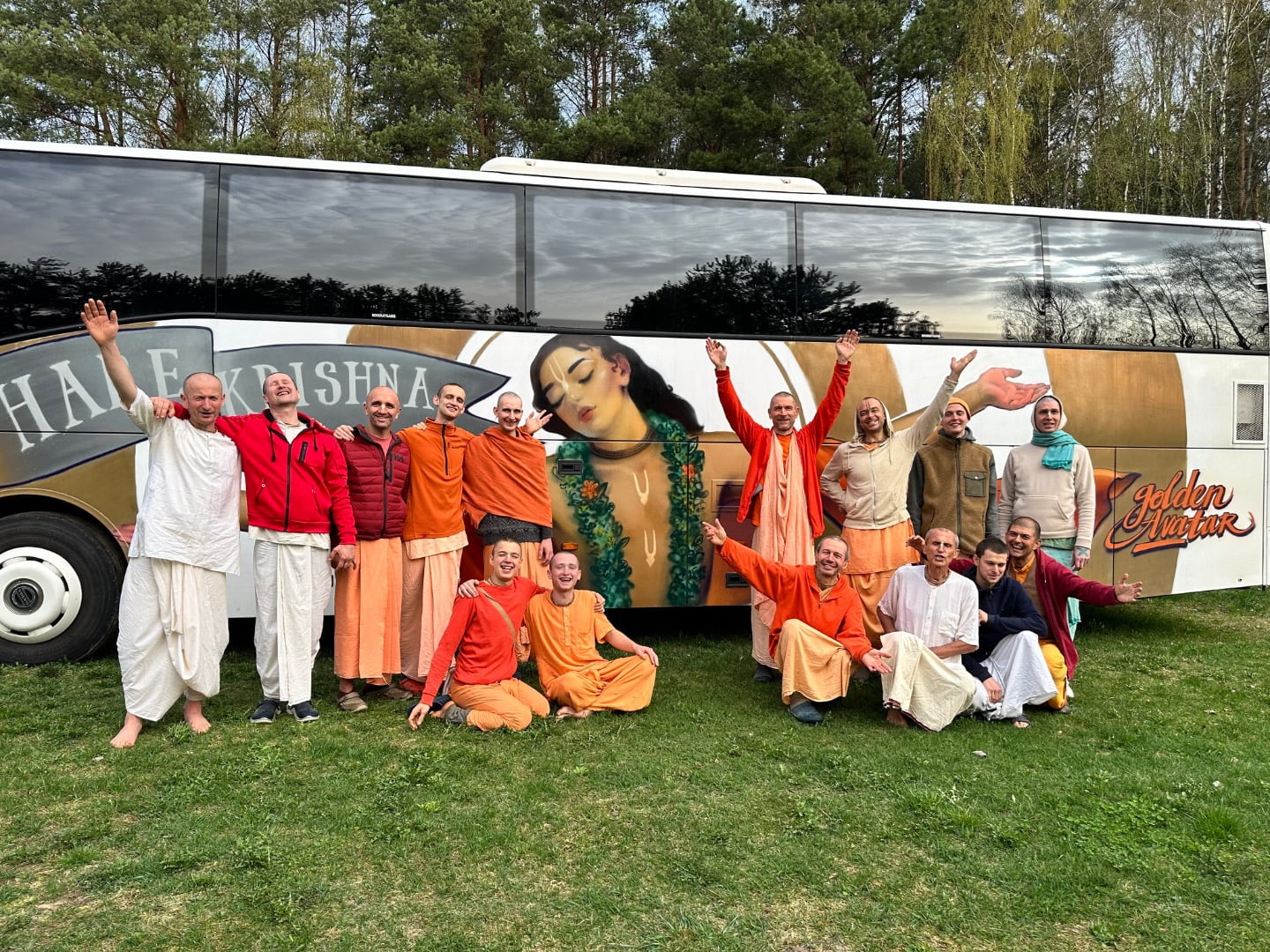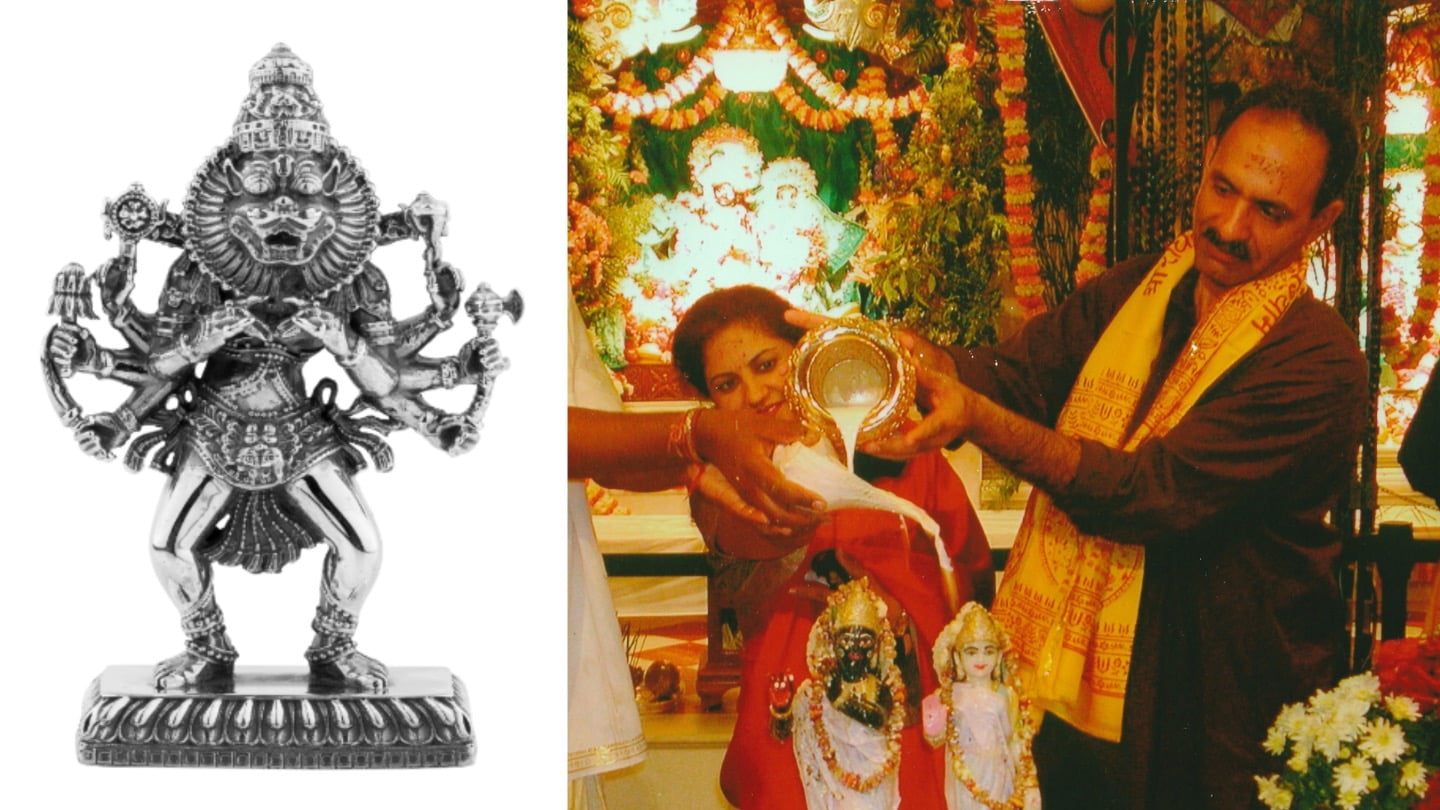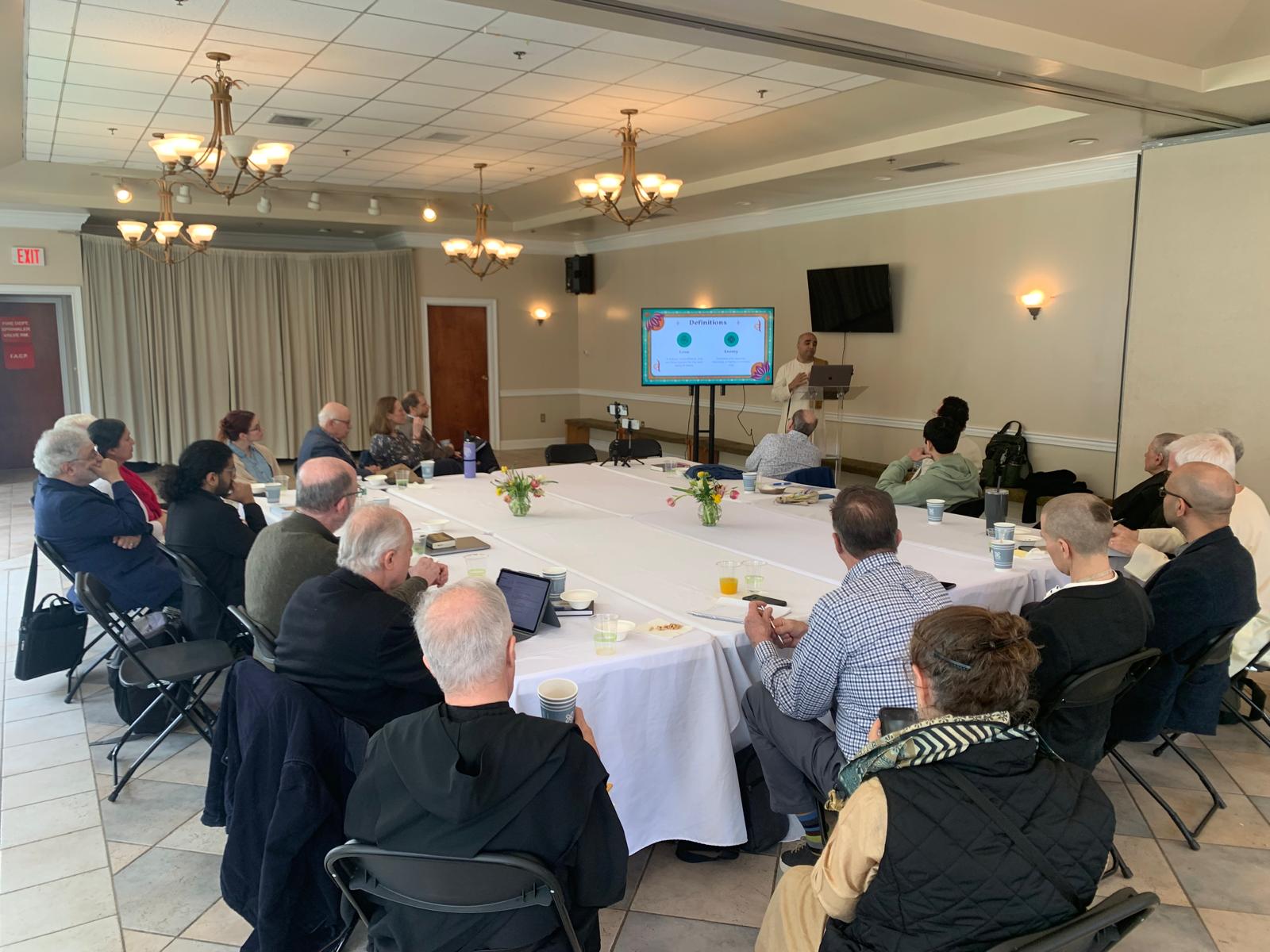Vrindavana’s 24-Hour Kirtan Promotes Constant Chanting
By Madhava Smullen | Feb 20, 2010
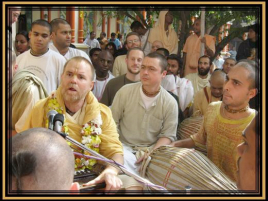
As Kirtan—India’s ancient call and response chanting—grows in popularity in western yoga circles, ISKCON devotees are keen to remind chanters of kirtan’s true focus of personal devotion to God. They’re also on a mission to spread awareness of Shri Chaitanya Mahaprabhu—the fifteenth century saint who is revered as none other than God himself by Gaudiya Vaishnavas—as the figure who introduced kirtan to the world.
And with Shri Chaitanya’s Appearance Day coming up on February 28th, there’s no better time than now to become absorbed in kirtan.
For Gopala Dasa, a second-generation ISKCON devotee who has been dedicated to kirtan resurgence for the past decade as part of Krishna Balarama Mandir’s 24 Hour Kirtan Department in Vrindavana, India, chanting and promoting kirtan is a way of life.
“Back in December, I was touring yoga studios in Mexico with ISKCON Youth Ministry’s Kirtan Yoga tour,” he says, “As well as participating in a 24-hour kirtan in Mexico City for New Year’s Eve. Right now, I am organizing a 72-hour kirtan in Mayapur, Chaitanya Mahaprabhu’s birthplace. Since the installation of deities of Pancha-Tattva—Mahaprabhu and his four closest associates—in 2004, it’s been a staple at the annual Mayapur Festival.”
On May 27th, Gopala will head back to his homebase of Vrindavana, Lord Krishna’s sacred birthplace, for another 72-hour kirtan. This time, the event will accompany the famous Boat Festival, wherein deities of Sri Sri Radha-Shyamasundara take a boat ride in Krishna Balarama Mandir’s water-filled courtyard.
Next, on June 19th, Gopala will attend the 24-Hour Kirtan Festival in New Vrindaban, West Virginia, a fast-growing event that saw 200 devotees attend in its first year, 500 the next, and 700 in 2009. “And what’s more, devotees are beginning to say that 24 hours isn’t long enough!” Gopala says. “So this year we may have 48 or even 72 hours of kirtan—the same traditional Gaudiya Vaishnava standard that the events in Mayapur and Vrindavana are following.”
Finally in winter 2010, Gopala will be jetting off to Mexico City once again, for another New Year’s Eve 24-hour kirtan.
Amazingly, all this only takes up two months of Gopala’s year. For the other ten months, he’s living in Vrindavana, India, and working as an assistant to Aindra Dasa, head of Krishna Balarama Mandir’s renowned 24 Hour Kirtan Department.
Behind the Scenes of the 24-Hour Kirtan
It was way back in the summer of 1996 that Gopala first happened to pop a CD called “Vrindavana Mellows” into his Walkman—a CD that would change his life forever.
“I had grown up with kirtan,” he says, “But this was like no other kirtan I’d ever heard before. When I closed my eyes, I felt like I was being transported to another dimension, right into the heart of the Vrindavana atmosphere. And I decided, right there and then, that I wanted to experience that kirtan for myself firsthand.”
Only a few months later Gopala moved to Vrindavana, getting a job as a teacher’s assistant in the international school there. During his spare time, he would go to the temple and play mridanga with the 24-Hour Kirtan band just as he had always imagined. Finally, in the year 2000, he moved into the Department’s ashrama accommodation, pledging a five-year full time commitment.
These days, he lives in his own apartment and assists with the needs of full-time members, while still playing mridanga for the 24-Hour Kirtan three hours a day.
“Full-time members do six hours of kirtan every day, as well as chanting Hare Krishna on their japa beads for two hours,” Gopala explains. “So basically, they are working full eight-hour days—except their job is simply to chant!”
The kirtaniyas, as they are known, each take two of the 24-Hour Kirtan’s three-hour shifts, which start at 1am and run continuously—24 hours a day, seven days a week, 52 weeks a year. The kirtan even runs during temple services such as arati offerings and lectures, with kirtaniyas softly chanting “japa kirtan” on their prayer beads.
The responsibility of taking a particular shift rotates monthly, so that kirtaniyas can have different experiences.
“Some shifts are peak times, when a lot of pilgrims are coming through the temple,” Gopala says, “While others are more quiet and relaxed periods. The most unique shift is probably the 1am shift until Mangala arati at 4:30am, when the kirtan is very mellow, peaceful background music for the pleasure of our sleeping Lordships.”
Gopala says that for him, this shift was a challenge, especially in winter—but that wasn’t necessarily a bad thing. “My mind would tell me, ‘Do you really want to be here chanting Hare Krishna, or do you want to go back to your warm sleeping bag?’” he laughs. “And that voice would get especially loud on the rare occasions when my only assigned chanting partner was sick or didn’t turn up for whatever reason, and I was there all alone. It was a test to see whether I really had a taste for the Holy Name. But when I passed it, I found that shift to be one of the most wonderful experiences of my life. The cold of winter would keep sounds of human activity quiet, and I could hear the peacocks and other nocturnal animals of Vrindavana. And as the moon shone through the open courtyard, its rays bouncing off the white marble of the temple room, I would feel as if I was in a completely different reality—a spiritual reality.”
There is, however, no denying the hardships of living in Vrindavana. It’s telling that there is no facility for women, and while married men are welcome to join the 24 Hour Kirtan department, the celibate students known as brahmacharis are prefered candidates—these are men that Department founder Aindra Dasa knows will stick it out through all conditions.
Three rooms in the Vrindavana International School’s ashram serve as the accommodation for the Department’s solid backbone crew of sixteen men. Each room has six basic bunks, a shelf for keeping personal items, and that’s pretty much it. With walls covered in cow dung in true ancient Vedic style, and, until three years ago, not even so much as an air conditioner, they’re sure to narrow down the crowd to only those who truly want to absorb themselves in Krishna’s name.
“It’s extremely austere,” Gopala says. “In the summer, the temperatures can rise to an unbelievable 45 Celsius (113 Fahrenheit). It was only recently that air conditioning became more affordable, and I took it upon myself to install units in each room. Vrindavana is already a very austere place—having a room where you can go to get a little respite from the heat can help keep you sane.”
Yet despite this tough picture, the crew of the 24-Hour Kirtan are well maintained. “They are all volunteers,” says Gopala, “But we provide them with clothes and food; if they get sick or have to go to the hospital we look after them; and if they need to go see their family or attend the Mayapur festival, we’ll pay for their tickets. We look after our crew.”
Such organization, however, was not always the norm.
The 24 hour Kirtan is Born
Krishna Balarama Mandir’s 24 Hour Kirtan was first introduced as far back as 1975, by ISKCON founder Srila Prabhupada. Without proper management, however, it began to fade, and by 1978, a year after Prabhupada passed on, it had ground to a halt.
Yet Krishna was already laying a plan for its salvation. Far away at ISKCON of Washington D.C, Prabhupada disciple Aindra Dasa was serving as a temple priest. Although not able to play any instrument, he was a lover of kirtan, and would play around with the harmonium in between services. Although other devotees were not encouraging, Aindra perservered, and worked out his first melody: the basic tune of Bhaktivinode Thakura’s short song Jaya Radha Madhava.
Gradually, he began to get more and more skilled at kirtan. Moving to New York City, he converted a truck that would open out into an ornate golden temple. He acquired sound permits and would drive to different parts of the city where he would set up his truck and perform kirtan for eight hours a day. His performances were successful, with several people joining ISKCON after seeing them.
Soon Aindra decided he would like to try organizing a kirtan program in India. Travelling to Vrindavana in 1986, he saw that the 24-hour kirtan Srila Prabhupada had once introduced had faded, and decided to dedicate himself to the project. Eight years after the program had first appeared, Aindra reconstituted it as its own department, organizing a core group of kirtan enthusiasts to ensure its continuance. The 24 hour kirtan of Krishna Balarama Mandir has been running non-stop ever since.
Aindra threw himself headlong into his new service. He began to soak up the atmosphere of Vrindavana, connect with other kirtaniyas, and learn Indian classical music or ragas, teaching himself the traditional melodies by ear.
Some of the Hare Krishna tunes he sang were ragas; others were Gaudiya Bengali melodies from Mayapur and Navadvipa. Still others, although based in raga, were invented by Aindra in a moment of inspiration while chanting japa.
Despite the very basic technology available in Vrindavana, and working against frequent power cuts, the 24-Hour Kirtan group began to record a series of albums. First came the double album Chintamani Nama Parts 1 and 2. Next, in 1993, ’94 and ’95 came the Vrindavana Mellows three part series, which took the devotee world by storm and set a new standard of kirtan within the Hare Krishna movement.
“Those albums changed everything,” Gopala says. “Before them, the old-school, 1980s, one-two-three style of kirtan pervaded. Vrindavana Mellows introduced a more classical approach in line with basic Gaudiya Vaishnava standards—one with more different varieties of rhythms, karatala playing, and raga melodies.”
After Vrindavana Mellows came Kirtan is Our Bhajan, a dynamic live kirtan that was spontaneously recorded. It was followed in 1996 by Prayers to the Dust of Vraja, while 1998 saw the release of another double album, Vraja Vilasa Parts 1 and 2.
Since then, the 24-Hour Kirtan has not released any more official recordings—although there have been many live bootlegs—choosing instead to focus on other projects. The group created a website, 24hourkirtan.com, that features information about its history and mission as well as profuse kirtan downloads. It also released a double DVD called “Hare Krishna Kirtan at Sri Vrindavana Dhama,” now available at Krishna.com. Initially filmed as a series of episodes for broadcast on India’s cable stations, the group are still working on a deal to air it in the future.
Meanwhile, after twelve years, the 24-Hour Kirtan has finally begun work on a new album, tentatively titled Vipralambha-Nama (The Holy Name in Separation). “Vrindavana Dasa and myself have been working on some mridanga guide tracks for the album,” Gopala says, “Creating the pencil sketch on which the full piece will be draped.”
“Kirtaniyah Sada Harih”
Throughout all their projects and album releases, the 24 Hour Kirtan group are ultimately trying to do one thing: realize Shri Chaitanya Mahaprabhu’s instruction of “kirtaniyah sada harih”—to chant the Holy Names of the Lord constantly.
“According to Vedic scriptures, there are three yugas, or ages—Satya, Treta, Dvapara, and Kali,” Gopala explains. “While in previous ages fire sacrifices, meditation or deity worship were recommended as the Yuga Dharma—the method of enlightment—the prescribed Yuga Dharma in this age of Kali is kirtan.”
While he admits that constant chanting is a lofty goal, Gopal explains that the 24-Hour Kirtan program creates a momentum towards that goal, keeping the Krishna conscious atmosphere very highly charged and absorbing people more and more in God’s names.
“The chanting benefits the devotees singing it—I’ve seen the profound Krishna conscious effects it has had on myself and others,” he says. “It benefits the guests and pilgrims that visit Krishna Balarama Mandir, who come by the hundreds and sometimes thousands per hour. When they see western devotees chanting Hare Krishna, in classical ragas that they can identify with, they are completely stunned. It benefits even the animate and inanimate living creatures in the immediate environment. And it benefits the entire world—the 24 Hour Kirtan is like a radio station beacon that’s sending out a maha-mantra signal across the globe… and since it’s coming from a holy place, the signal is infinitely boosted.”
Aindra and his 24 Hour Kirtan team are also doing practical work towards increasing the focus on kirtan in the ISKCON world. A ten point-agenda on 24hourkirtan.com encourages devotees around the world to start a kirtan resurgency in their area, and an international action network of devotees seriously dedicated to this cause, called the Yuga-dharma-nama-sankirtan Resurgence Coalition, has already sprung up.
“We feel that while kirtan used to be the main agenda of the Hare Krishna movement, many other projects have taken precedence as ISKCON has progressed and developed,” Gopala says. “So the Yuga-dharma-nama-sankirtan Resurgence Coalition encourages Vaishnava managers and individuals to once again prioritize the daily propagation of the Holy Names.”
As part of its resurgence plan, the 24-Hour Kirtan Department offers short or long-term kirtan experience and training opportunities for serious candidates at the Krishna Balarama Mandir, and encourages similar programs at venues around the world. “Our department is there to get devotees more fired up for kirtan,” Gopala says. “People have come, spent time with us, and then moved on, taking kirtan with them and incorporating it into their lives. Mauritius-born kirtaniya Madhava, for instance, spent around five years with the department as a celibate monk, then moved on and got a job and family life. But he has kept kirtan a consistent part of his life. And many others have done the same.”
With more and more kirtan-centered events popping up around the world, and an increased saturation of Gaudiya Vaishnava Hare Krishna chanters in the popular yoga market, it looks like the the mission of Aindra and his 24-Hour Kirtan team is being realized.
And ultimately, so too is the mission of Srila Prabhupada, put so memorably at the annual meetings of ISKCON’s Governing Body Commission back in 1977:
“Yes, everywhere this chanting should go on. Instead of meetings, resolutions, dissolutions, revolutions, and then no solutions, there should be chanting.”





